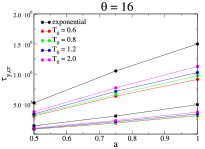** Progress in Earth and Planetary Science is the official journal of the Japan Geoscience Union, published in collaboration with its 51 society members.
** Progress in Earth and Planetary Science is partly financially supported by a Grant-in-Aid for Publication of Scientific Research Results to enhance dissemination of information of scientific research.
Gallery View of PEPS Articles
Research
Space and planetary sciences
201507201507
Towards scaling laws for subduction initiation on terrestrial planets: constraints from two-dimensional steady-state convection simulations
Wong T and Solomatov V S
Convection, Stress, Lithosphere, Subduction, Plate tectonics
Comparison of stress profiles of exponential viscosities for θ=16, R a=3×10 7 , and varying a. (Figure.2)
Critical yield stress τ y,c r as a function of aspect ratio. Circles represent Ra = 3 ×10 7 , squares Ra = 10 7 , diamonds Ra = 3 ×10 6 . (Figure 32)
The strongly temperature-dependent viscosity of rocks leads to the formation of nearly rigid lithospheric plates. Previous studies showed that a very low yield stress might be necessary to weaken and mobilize the plates, for example, due to water. However, the magnitude of the yield stress remains poorly understood. While the convective stresses below the lithosphere are relatively small, sublithospheric convection can induce large stresses in the lithosphere indirectly, through thermal thinning of the lithosphere. The magnitude of the thermal thinning, the stresses associated with it, and the critical yield stress to initiate subduction depend on several factors including the viscosity law, the Rayleigh number, and the aspect ratio of the convective cells. We conduct a systematic numerical analysis of lithospheric stresses and other convective parameters for single steady-state convection cells. Such cells can be considered as part of a multi-cell, time-dependent convective system. This allows us a better control of convective solutions and a relatively simple scaling analysis. We find that subduction initiation depends much stronger on the aspect ratio than in previous studies and speculate that plate tectonics initiation may not necessarily require significant weakening and can, at least in principle, start if a sufficiently long cell develops during planetary evolution.







